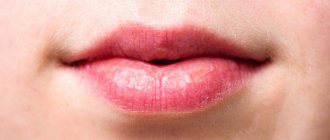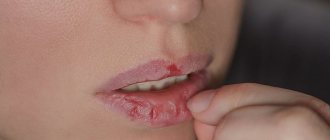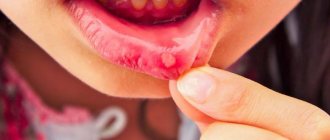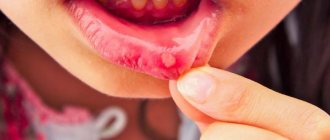Why do lips dry out?
Before looking for a way to quickly moisturize your lips, you should find out the cause of the problem. Depending on what formed the basis for the lack of moisture, you can choose a suitable remedy for complete restoration.
Causes of dry lips:
- Harmful environment. Cold, heat, windy weather and poor air quality. Cold and heat provoke a decrease in moisture in tissues. The condition worsens during strong winds.
- Stress. Situations when a person is very nervous and involuntarily licks his lips (a standard human reaction). The saliva that covers the delicate skin dries quickly, drying out the problem area.
- Medicines that affect the salivary glands, for example, drugs aimed at reducing appetite.
- Oral care products with high fluoride content. The element is characterized by a dehydrating effect. Thin skin is not able to retain moisture for a long time, as the dermis does on other parts of the body.
- Cosmetics: long-lasting lipsticks, matte formulations, tints and products with a dry/powdery effect. Pigments for artistic makeup. Powdering for better durability of conventional products speeds up drying.
- Unhealthy lifestyle: poor nutrition worsens the situation with vitamin saturation of the whole body. Lack of water (maintaining water balance is the key to health), alcohol, and tobacco are harmful.
- Diseases that cause dry mouth. These include allergic reactions, lip burns, dental diseases, inflammatory pathologies, bacterial and hormonal diseases.
Excessive dryness can be caused by a cold with a profuse runny nose and nasal congestion. With frequent inhalation and exhalation through the mouth, the lips become chapped and dry. During such a period, it is especially important to know how to keep your lips moisturized.
Treatment of cheilitis
Treatment of the disease depends on the causes of its occurrence. For example, to treat allergic cheilitis, drugs are used that reduce the body’s sensitivity to allergens - antihistamines, as well as vitamins. Zinc ointment, anti-inflammatory creams containing glucocorticoids, salicylic acid, and sulfur are used externally. Avoid substances that irritate the mucous membrane of the mouth and lips. After eating, rinsing with chamomile infusion or soda is useful. To determine the allergen, it is necessary to conduct allergy tests.
For fungal cheilitis, antifungal drugs are prescribed in combination with vitamin B2 and ascorbic acid. An examination by a dentist and, if necessary, complete sanitation of the oral cavity and thorough treatment of problem areas with oil solutions of vitamins are recommended. To prevent relapses, a diet with limited carbohydrates is prescribed. In the treatment of exfoliative cheilitis, corticosteroid and photoprotective ointments, 2% boric salicylic acid ointment are widely used. In the presence of an exudative form of exfoliative cheilitis, Bucca radiation is effective.
Diagnosis of this disease is carried out by several doctors: a therapist, a dentist, an allergist. A combination of systemic (general) and topical (local) drug therapy produces a good effect.
Back to articles
What should healthy lips look like?
Those who know how to moisturize their lips can boast of their naturally beautiful appearance. The natural red hue is due to the location of blood vessels near the surface.
Signs of healthy lips:
- smooth skin;
- smooth texture;
- pleasant natural shade;
- no peeling or cracking.
Healthy lips have even, uniform pigmentation without light or dark areas. Healthy skin looks elastic, it is not prone to irritation, peeling and allergies.
If a whitened area is detected, it means that the delicate skin does not receive enough hydration or there are not enough vitamins in the body:
- A,
- E,
- WITH.
First you need to learn how to use the right cosmetics. This applies to all people, because even if there are no problems with the lips, a careful attitude will not be superfluous.
You need to be able to choose the right cosmetics. And the first thing people pay attention to is the composition. Oil-based products should contain only natural ingredients:
- jojoba oil,
- cocoa,
- shi,
- nut oils.
It is best to buy products at a pharmacy or labeled “pharmacy product”. This means that cosmetics:
- passed dermatological tests,
- approved by experts
- considered safe.
In addition to moisturizers, there are small life hacks to improve the color and contour of your lips.
Shock freezing is often used: using ice to massage the lips. With prolonged exposure to cold, the appearance of the lips deteriorates, but short periods of exposure to shock cold cause the capillaries to expand sharply. Blood flows closer to the skin and provides:
- more active saturation with oxygen and nutrients,
- more saturated lip color.
The most common advice for lip care is the use of special lipstick. But there are several ways to moisturize your lips without chapstick.
Symptoms of cheilitis
The disease manifests itself in a variety of symptoms; common complaints include swelling, redness, peeling of the lips, the appearance of bleeding ulcers, purulent crusts, burning and pain when opening the mouth and eating.
There are several forms of this pathology:
- Catarrhal
- Glandular
- Exfoliative
- Eczematous
- Candida
- Allergic
The causes of catarrhal cheilitis are usually injuries, weather conditions, and chemical damage. This form of the disease manifests itself in the form of diffuse inflammation of the lips, swelling, redness, and peeling.
With glandular cheilitis, the mucous glands of the lips become inflamed. The disease can occur against the background of injuries with the addition of infection. The presence of bad habits can also contribute to the development of this form of cheilitis.
The disease manifests itself as enlarged glands, discharge of pus, and increased lip volume. Often, as a result of such an inflammatory process, the lips do not restore their previous shape, since changes in the form of cysts form in the labial glands.
Exfoliative cheilitis is divided into dry and exudative. Exfoliative cheilitis is more common in women. With dry exfoliative cheilitis, yellow scales appear on the lips and dryness is pronounced. In addition, the red border of the lips is affected by dyskeratosis.
The exudative form of exfoliative cheilitis is characterized by severe pain, swelling of the lip, and the presence of abundant crusts that make speech and eating difficult. Sometimes the crusts hang down in the form of an apron when the exudative phenomena are significant. Candidal cheilitis is provoked by the fungal infection Candida albicans, and this form of the disease is often combined with stomatitis.
Various allergens can cause another form of cheilitis - eczematous. This type of cheilitis occurs when there is an allergy to cosmetics, a lack of B vitamins in the body, or chronic injury to the lips. In addition, allergic (eczematous) cheilitis occurs due to increased sensitivity of the red border of the lips to chemicals (for example, dyes) included in toothpaste, lipstick, and dentures. It occurs with swelling and redness of the red border of the lips, then becomes covered with abundant scales and crusts, and painful cracks form in places.
Causes of cheilitis
Exposure to adverse weather conditions.
The disease often develops as a result of exposure to unfavorable climatic factors, which include ultraviolet radiation, too low or high air temperature. For this reason, cheilitis often affects people whose work involves regular exposure to fresh air.
Development of an allergic reaction.
One of the reasons for the development of cheilitis is an increase in the sensitivity of the lips to various irritants, mainly of chemical origin.
In this case, the area of the red border of the lips is most often affected and, less often, the mucous membrane. If you do not consult a doctor in a timely manner and do not undergo treatment, the disease can spread to the skin surrounding the lips. Most often, the disease develops due to the use of lipsticks. This is explained by the fact that their composition includes the dye eosin and specific fluorescent substances. The plastic of dentures, aromatic fillers included in toothpastes, etc. can also act as irritants. The disease mainly affects women aged 20-60 years.
Presence of an underlying disease.
Cheilitis on the lips can be a symptom of some disease and manifest itself against the background of neurodermatitis or atopic dermatitis. Eczematous cheilitis is formed with various eczemas, macrocheilitis - with neuritis of the facial nerve in combination with a folded tongue. The most common cause of the disease is dermatoses. The skin of the lips, mucous membrane and red border can also become inflamed with systemic and infectious diseases (psoriasis, tuberculosis, lichen planus, erythematoses, etc.).
Up to contents
Reasons for the development of the disease
The most common cause of the disease is heredity. Also among the provoking factors are the presence of allergies, reduced immunity, lack of nutrients and vitamins in the diet, and chronic diseases.
Atopic cheilitis and intestinal dysbiosis are often associated. Chronic stress, disruptions in the endocrine system, bad habits and exposure to certain medications can also influence its appearance. Among the allergens that can trigger the development of this disease are dust, pollen, food products, dyes and some medications.
ICD-10
In medicine, a group of diseases of the lip mucosa is designated by a special code - K13.0 .
The classification defines these pathologies as diseases of a benign nature with diverse causes of their occurrence.
The section includes a number of diseases: abscess, fistula, cellulite of the lips, their jams, cracks, hypertrophy and the main forms of cheilitis and cheilosis, which arise as independent pathologies and as a symptom of underlying diseases. Their nature can be different, both inflammatory and degenerative.
Fungal infections of the lips are excluded from this subgroup; they are classified in heading B37.83. Separately, this official document highlights cheilosis due to vitamin A hypovitaminosis (E53.0) and allergic cheilitis, included in block L20-L30.
Cheilitis on the lips: photo
Varieties of cheilitis in medicine are grouped by doctors into subgroups according to certain characteristics:
1. According to the speed and characteristics of the process (acute, chronic, latent, in the acute phase).
2. By origin: cheilitis itself (actinic, meteorological, allergic, etc.) or symptomatic (atopic; lip eczema, Melkersson-Rosenthal syndrome, etc.).
Prevention methods
Careful oral hygiene
To prevent the appearance of cracks, you need to protect the skin and mucous membranes from adverse effects. To do this, you should get rid of the habit of licking your lips and corners of your mouth, using medicinal cosmetics for dry skin and hygienic lipsticks. To prevent infection from getting onto the skin of the lips from the oral cavity, it is necessary to brush your teeth at least twice a day, as well as treat caries and inflammatory gum diseases.
Changing your diet
If pockets begin to appear in the corners of the mouth, it is necessary to limit the consumption of spicy, sour and salty foods that irritate the mucous membranes and skin. You can add non-acidic fruits and vegetables to your daily diet, as well as foods containing iron and riboflavin (beef, liver, dairy products, cabbage, potatoes, peanuts, almonds, etc.).
Up to contents
Classification of cheilitis
Primary (independent)
- Glandular
This lip disease is caused by acquired or congenital enlargement of the minor salivary glands and their infection. Most often it affects people over 30 years of age. It is worth noting that the upper lip is affected 2 times less often than the lower lip. At the beginning of the development of the disease, patients are concerned about peeling and slight dryness of the lips. If left untreated, pain may occur due to cracks and erosion.
- Exfoliative
This disease affects only the red border of the lips and is accompanied by peeling.
In most cases, women suffer from this disease. In the dry form, scales form on the lips, a feeling of dryness and burning appears; in the exudative form, swelling and abundant crusts form, making it difficult to eat and speak.
- Contact allergic
This disease is caused by a delayed allergic reaction to various irritants upon contact with the red border of the lips. In most cases, this disease affects women over the age of 20. Signs include redness of the lips, swelling, burning and severe itching. With repeated contact with the irritant, the disease worsens. If treatment for cheilitis is not started in a timely manner, the lip becomes covered with small blisters, after which cracks and erosion appear.
- Meteorological
This disease is caused by increased sensitivity to ultraviolet radiation, wind or cold. In most cases, it affects men aged 20 to 60 years. The exudative form is characterized by itching, burning of the lips, and the appearance of erosion. Small bubbles may appear, after opening which crusts form. In the dry form, erythema of the lips is observed, small white-gray scales appear. If left untreated, abrasions and erosion may develop in the future.
Secondary (symptomatic)
- Atopic
It is believed that this type of disease is one of the manifestations of atopic dermatitis. Patients complain of slight swelling of the red border of the lips, while adjacent areas of the skin are involved in the inflammatory process. Also, manifestations of the disease include damage to the corners of the mouth. When acute inflammation begins to subside, the lip begins to peel off. As a result of dryness in the corners of the mouth, cracks form. In the absence of comprehensive treatment, peeling of the facial skin is possible.
- Eczematous
This disease develops against the background of eczema, which results in inflammation of the surface layers of the skin. In the acute stage, patients complain of redness of the lips, burning and itching. In this case, each lip swells, erythema and pathological changes in the skin are observed. If there is no comprehensive treatment, the disease becomes chronic. In this case, acute inflammatory phenomena (hyperemia, edema) decrease, inflammatory infiltration develops, and nodules and scales may form.
- Hypovitaminosis
This disease in most cases develops against the background of hypo- or avitaminosis of group B. Symptoms of cheilitis include burning and dryness of the tongue, lips and oral mucosa. If the disease is not treated, vertical small cracks appear on the red border of the lips, which often bleed. The tongue may increase in size, and teeth marks are often visible on it.
Up to contents










